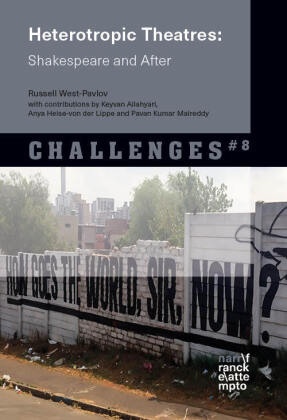Heterotropic Theatres - Shakespeare and After
| Verlag | Narr |
| Auflage | 2025 |
| Seiten | 390 |
| Format | 16,0 x 3,0 x 22,7 cm |
| Gewicht | 750 g |
| Artikeltyp | Englisches Buch |
| Reihe | Herausforderungen für die Geisteswissenschaften - Challenges for the Humanities 8 |
| ISBN-10 | 3381133217 |
| EAN | 9783381133215 |
| Bestell-Nr | 38113321A |
This book seeks to elaborate a theory of 'troping' that expands the purview of linguistic work and agency, parsing its transformative work beyond the limits usually set it by theories of language. It registers a sea-change in the theorization of theatrical art from representation to intervention. Focussing on early modern theatre from Shakespeare to the Restoration, it seeks to lay bare the activity of language as a heterotropology.
This book seeks to elaborate a theory of 'troping' that expands thepurview of linguistic work and agency, parsing its transformative work beyond the limits usually set by theories of language. It registers a sea-change in the theorization of theatrical art from representation to intervention. The book thereby seeks to lay bare the activity of language as a heterotropology. It focuses on early modern theatre from Shakespeare (Hamlet, Macbeth, Romeo and Juliet, Troilus and Cressida) and other theatrical forms of the same era (the Court Masque, dramas by Ford or Johnson) through to the Restoration; it also reads a number of contemporary avatars of Shakespearean texts from Stoppard to Jones, and of early modern and postmodern performance spaces such as the New Globe Theatre. In a dozen readings of early modern theatre it asks how the remarkable energy and social purchase ascribed to theatrical language by contemporary commentators can be reconceptualized, mobilized anew and thus harne ssed for our own turbulent times.
Inhaltsverzeichnis:
INTRODUCTION: Troping the Early Modern, Re-Troping the Present (Hamlet)CHAPTER 1: Heterotropologies: Towards a theory of the theatrical trope (Hamlet and chiasmus)CHAPTER 2: The Contemporary Transformations of Spatial Experience - and their Fall-Out: Rosencrantz and Guildenstern are Dead and HamletCHAPTER 3: The Court, the Masque, and FrictionCHAPTER 4: Cultural Catachresis, Cultural Memory and the New Globe TheatreCHAPTER 5:Feminine Sexuality, Incest and Gender Coercion in Ford's 'Tis Pity She's a Whore .CHAPTER 6: Un-Fashioning Gendered Bodies on the Restoration Stage (Etheredge's Man of Mode)CHAPTER 7: Time, Space, Emulation and Violence in Troilus and CressidaCHAPTER 8: Deadly Affect and Moribund 'Epochality' in Troilus and CressidaCHAPTER 9: 'Have you a mind to sink?' - Imagining Liminal and Oceanic Spatiality in King Lear, Hamlet and The Tempest (Anya Heise-von der Lippe)CHAPTER 10: Shakespeare's Aquatopia: The Tempest in an Age of Blue Humanities (Pavan Kumar Malreddy)CHAPT ER 11: Postcolonial Texts, Colonial Intertexts and their Imbrications - Macbeth and the Sonnets in Gail Jones's Sorry.CHAPTER 12: Macbeth, Auerbach, Vladislavic - Figural readings and temporalities of crisis in JohannesburgCHAPTER 13: Exceptional Shakespeare: (Mediated) Rendition and the Carceral Middle East in Iqbal Khan's Othello (Keyvan Allahyari) CODA: What is my contemporary? (Romeo and Juliet)BIBLIOGRAPHYACKNOWLEDGEMENTS

